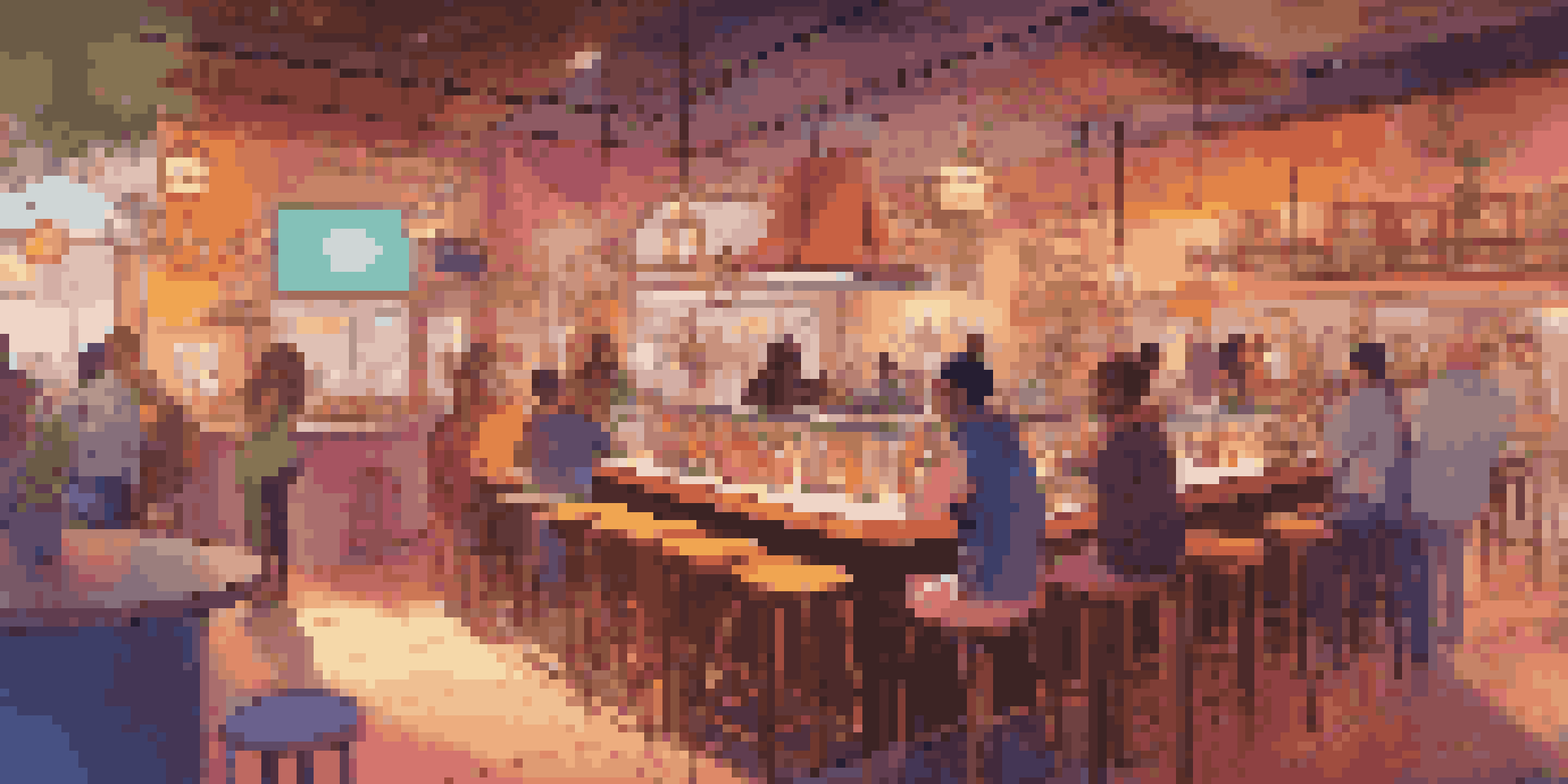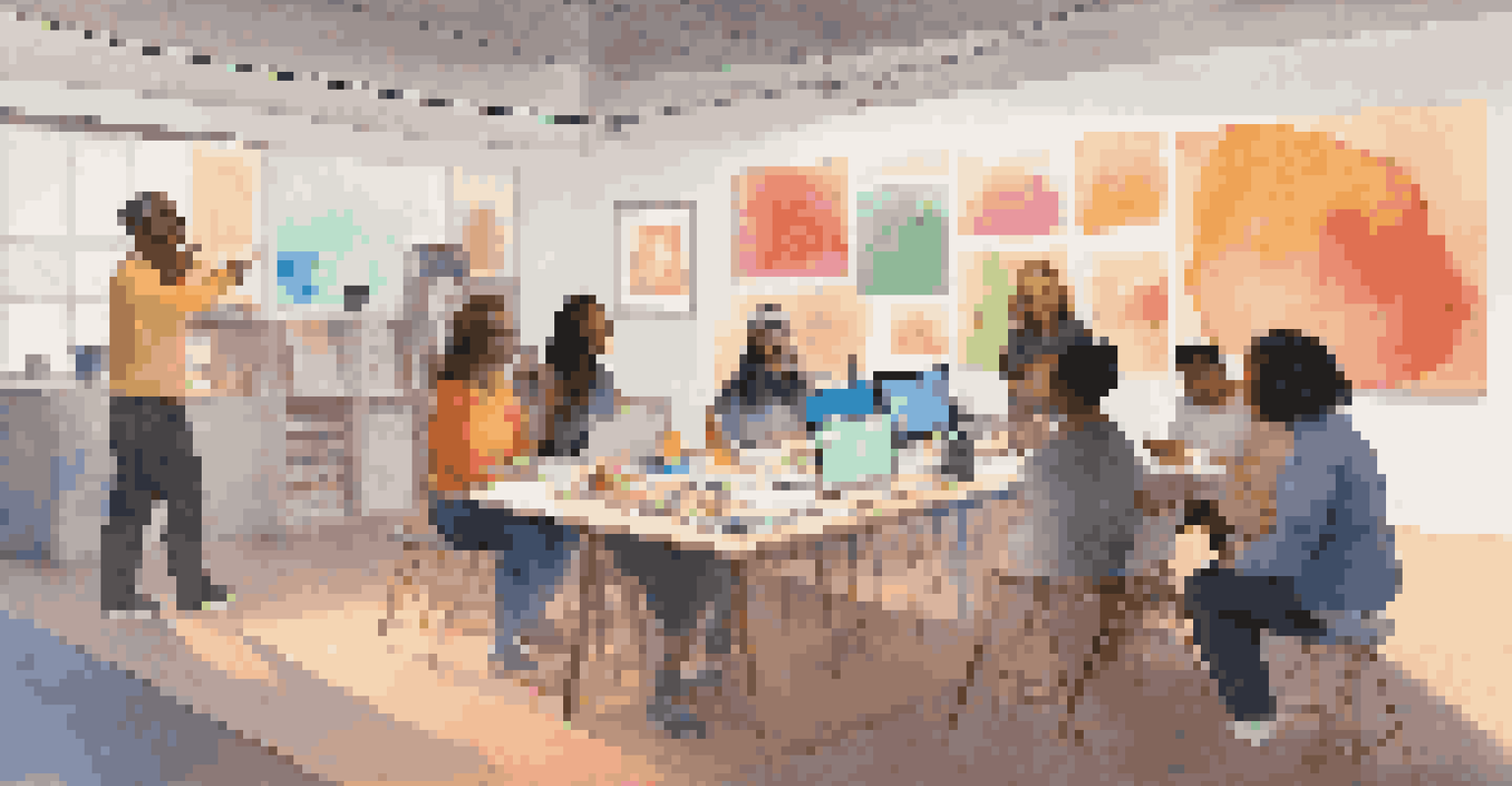Building Community in Virtual Reality: Social Spaces and Events

The Rise of Virtual Reality Social Spaces
Virtual reality (VR) social spaces are transforming how we connect. Unlike traditional online platforms, VR immerses users in a three-dimensional environment, allowing for more natural interactions. Imagine stepping into a digital café where you can chat with friends as if you were all physically together; that’s the magic of VR. This immersive experience enhances the feeling of presence, making conversations feel more authentic and engaging.
The great thing about virtual reality is that it allows you to experience things you would never be able to in real life.
As VR technology advances, more platforms emerge that cater specifically to social interaction. Spaces like VRChat and AltspaceVR provide users with various environments, from casual hangouts to themed events. These platforms are not just about gaming; they serve as vibrant communities where people can share interests, attend events, and even participate in workshops. The possibilities for connection are endless, inviting users to explore new social dynamics.
Moreover, these VR social spaces are breaking down geographical barriers. You can meet someone from halfway across the world as easily as a neighbor next door. This inclusivity fosters a sense of global community, where diverse perspectives enrich conversations. As we embrace these virtual environments, the way we build relationships is evolving, giving rise to new forms of community.
Creating Meaningful Connections in VR
While VR provides unique social opportunities, creating meaningful connections requires intention. Users can engage in activities like collaborative games, art projects, or discussions that encourage deeper interaction. For example, participating in a group painting session can spark conversations about creativity and personal experiences, fostering a sense of camaraderie. It’s these shared activities that often lay the groundwork for lasting friendships.

Additionally, the use of avatars allows individuals to express themselves in ways they might not feel comfortable in real life. This freedom can lead to more authentic interactions, as users feel less constrained by societal norms. Imagine a shy person finding their voice as they embody a vibrant avatar, sharing stories and laughter with others. This unique aspect of VR can enhance social confidence and encourage openness.
VR Transforms Social Connections
Virtual reality creates immersive environments that enhance authentic interactions and foster a sense of presence among users.
However, it’s essential to recognize that building connections is not just about the technology; it also depends on the community’s culture. Establishing norms around respect, inclusivity, and kindness can attract diverse participants, making the virtual space welcoming. By nurturing a positive atmosphere, users can thrive, creating bonds that transcend the digital realm.
Hosting Events in Virtual Reality
One of the most exciting aspects of VR is its ability to host events that bring people together. Whether it’s a virtual concert, a book club meeting, or a networking event, the possibilities are vast. Organizers can design unique experiences that engage participants in ways traditional events cannot. Picture attending a concert where the stage is right in front of you, and you can even interact with other attendees as if you were in the front row.
Inclusion is not a matter of political correctness. It is the key to growth.
The flexibility of virtual spaces also allows for creative event planning. Hosts can customize environments to fit the theme, using vibrant visuals and interactive elements to enhance the experience. For instance, a sci-fi themed meetup could take place on a spaceship, complete with futuristic decor and sound effects. This level of customization not only captivates attendees but also encourages them to immerse themselves fully in the experience.
Moreover, virtual events can accommodate larger audiences without the constraints of physical space. This opens doors for global participation, allowing individuals from various backgrounds to connect and share ideas. As we see more events transition to VR, we are reminded that community building knows no bounds, inviting everyone to join the conversation.
The Role of Moderation in VR Communities
As with any community, moderation is crucial in virtual reality spaces. Effective moderation ensures that interactions remain positive and respectful, which is essential for fostering a welcoming environment. Communities can establish guidelines that set the tone for behavior, helping users understand what is expected. Think of it as a digital handshake, setting the stage for a friendly encounter.
Moderators play a vital role in maintaining this atmosphere by addressing conflicts and providing support. They can facilitate discussions, encourage participation, and step in during uncomfortable situations. Just like a good host at a party, a moderator helps keep the conversation flowing and ensures everyone feels included. This proactive approach can significantly enhance the overall experience for participants.
Building Community Requires Intention
Establishing meaningful connections in VR depends on engaging activities and a culture of respect and inclusivity.
Additionally, incorporating user feedback helps evolve community guidelines over time. By listening to members, moderators can create a space that reflects the values and needs of its users. This collaborative effort not only strengthens community bonds but also fosters a sense of ownership among participants, making them more invested in maintaining a positive environment.
Fostering Inclusivity in Virtual Spaces
Inclusivity is a fundamental aspect of building a vibrant community in virtual reality. It’s essential to create spaces where everyone feels welcome, regardless of their background or identity. Developers and community leaders can implement features that accommodate diverse needs, such as customizable avatars and accessible environments. Imagine a space where everyone can express their individuality, making it all the more enriching.
Moreover, highlighting diverse voices in events and activities can enhance the sense of belonging. By showcasing various cultures, experiences, and perspectives, communities can create a tapestry of shared knowledge and creativity. For instance, hosting cultural festivals or panels can celebrate diversity while educating participants, fostering appreciation for different backgrounds.
Encouraging open dialogue about inclusivity also plays a crucial role. Community members should feel empowered to voice their experiences and suggestions for improvement. This collaborative approach not only builds trust but also helps identify areas where the community can grow. By prioritizing inclusivity, virtual reality spaces can become havens for connection and creativity.
The Future of Community in Virtual Reality
As technology evolves, so does the potential for building community in virtual reality. We are likely to see advancements that enhance user experiences, making interactions even more immersive and engaging. For instance, developments in haptic feedback could allow users to feel sensations, such as a friend’s handshake or a high-five, bringing a new dimension to virtual interactions. This kind of innovation will further bridge the gap between digital and physical connections.
Additionally, the rise of artificial intelligence (AI) could play a significant role in moderating and enhancing experiences within virtual spaces. AI can help personalize interactions, suggesting activities or connections based on user preferences and behavior. Imagine a virtual assistant guiding you to like-minded individuals or events, enriching your community experience by introducing you to new friends.
Future Innovations in VR Communities
Advancements in technology, such as AI and haptic feedback, will further enhance user experiences and community building in virtual reality.
Ultimately, the future of community in VR will depend on the choices we make today. By prioritizing inclusivity, creativity, and meaningful connections, we can shape a vibrant digital landscape that enhances our social lives. As we continue to explore these possibilities, the potential for community-building in virtual reality is limitless, inviting everyone to join in the journey.
Conclusion: Embracing the Virtual Community
Building community in virtual reality is an exciting frontier that offers unique opportunities for connection. As we navigate through these digital landscapes, we discover new ways to engage, interact, and forge relationships. The key lies in creating inclusive spaces where everyone can participate and feel valued. This approach not only enhances individual experiences but also enriches the community as a whole.
By hosting events, fostering meaningful connections, and ensuring a welcoming environment, we can cultivate a thriving virtual community. The potential for creativity and collaboration is boundless, allowing us to explore shared interests and passions. As we embrace this virtual community, we not only enhance our social lives but also contribute to a more connected and empathetic world.

In conclusion, the journey of building community in virtual reality is just beginning. As technology continues to evolve, so will our methods of connection. Let’s embrace these opportunities, engage with diverse voices, and create spaces where everyone can thrive. The future of community is bright, and it’s time to step into this exciting new world together.